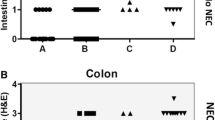Abstract
Purpose
Feeding and systemic hypoxia are major stresses inducing necrotizing enterocolitis (NEC). This study aims to investigate the role of systemic hypoxia in NEC and its effect before and after feeding.
Methods
Neonatal mice were studied in three groups. Control (N = 9): breast feeding; NEC A (N = 8), gavage feeding + lipopolysaccharide (LPS) + preprandial hypoxia; and NEC B (N = 9), feeding + LPS + postprandial hypoxia. Pimonidazole, a hypoxia marker, was injected intraperitoneally before ileum was harvested for histology and quantitative RT-PCR studies. Statistical analysis was done using the ANOVA and Chi-square test.
Results
NEC incidence was 62.5% in NEC A and 88.9% in NEC B. The mortality in NEC B (55.6%) but not A (25%) is significantly higher than control (0%, p < 0.05). Pimonidazole staining elevated in both NEC A and B with higher pimonidazole grade in NEC B (p < 0.01). Both NEC groups had increased the expression of hypoxia-related genes: HIF-1α, GLUT-1, and PHD-3 with GLUT-1 expressed more in NEC B compared with NEC A (p < 0.01). The inflammation marker, IL6, was similarly raised in both NEC A and B.
Conclusion
Feeding and postprandial hypoxia synergistically induce intestinal hypoxia in NEC. As feeding increases intestinal oxygen demand, maintaining a balance between intestinal oxygen supply and demand is important to prevent NEC.



Similar content being viewed by others
References
Fitzgibbons SC, Ching Y, Yu D et al (2009) Mortality of necrotizing enterocolitis expressed by birth weight categories. J Pediatr Surg 44:1072–1075
Holman RC, Stoll BJ, Curns AT et al (2006) Necrotising enterocolitis hospitalisations among neonates in the United States. Paediatr Perinat Epidemiol 20:498–506
Neu J, Walker WA (2011) Necrotizing enterocolitis. N Engl J Med 364:255–264
Ballance WA, Dahms BB, Shenker N et al (1990) Pathology of neonatal necrotizing enterocolitis: a ten-year experience. J Pediatr 117:S6–S13
Sharma R, Hudak ML (2013) A clinical perspective of necrotizing enterocolitis: past, present, and future. Clin Perinatol 40:27–51
Chen Y, Chang KT, Lian DW et al (2016) The role of ischemia in necrotizing enterocolitis. J Pediatr Surg 51:1255–1261
Hsueh W, Caplan MS, Qu XW et al (2003) Neonatal necrotizing enterocolitis: clinical considerations and pathogenetic concepts. Pediatr Dev Pathol 6:6–23
Ward JB, Keely SJ (2014) Oxygen in the regulation of intestinal epithelial transport. J Physiol 592:2473–2489
Young CM, Kingma SD, Neu J (2011) Ischemia-reperfusion and neonatal intestinal injury. J Pediatr 158:e25–e28
Scholander PF (1963) The master switch of life. Sci Am 209:92–106
Caplan MS, Hedlund E, Adler L et al (1994) Role of asphyxia and feeding in a neonatal rat model of necrotizing enterocolitis. Pediatr Pathol 14:1017–1028
Zani A, Zani-Ruttenstock E, Peyvandi F (2016) A spectrum of intestinal injury models in neonatal mice. Pediatr Surg Int 32:65–70
Radulescu A, Zhang HY, Yu X et al (2010) Heparin-binding epidermal growth factor-like growth factor overexpression in transgenic mice increases resistance to necrotizing enterocolitis. J Pediatr Surg 45:1933–1939
Zani A, Cordischi L, Cananzi M et al (2008) Assessment of a neonatal rat model of necrotizing enterocolitis. Eur J Pediatr Surg 18:423–426
Fisher EM, Khan M, Salisbury R et al (2013) Noninvasive monitoring of small intestinal oxygen in a rat model of chronic mesenteric ischemia. Cell Biochem Biophys 67:451–459
Aprelikova O, Chandramouli GV, Wood M, Vasselli JR, Riss J, Maranchie JK, Linehan WM, Barrett JC (2004) Regulation of HIF prolyl hydroxylases by hypoxia-inducible factors. J Cell Biochem 92:491–501
Elson DA, Ryan HE, Snow JW et al (2000) Coordinate up-regulation of hypoxia inducible factor (HIF)-1alpha and HIF-1 target genes during multi-stage epidermal carcinogenesis and wound healing. Cancer Res 60:6189–6195
Madsen JL, Sondergaard SB, Moller S (2006) Meal-induced changes in splanchnic blood flow and oxygen uptake in middle-aged healthy humans. Scand J Gastroenterol 41:87–92
Sieber C, Beglinger C, Jaeger K et al (1991) Regulation of postprandial mesenteric blood flow in humans: evidence for a cholinergic nervous reflex. Gut 32:361–366
Fang S, Kempley ST, Gamsu HR (2001) Prediction of early tolerance to enteral feeding in preterm infants by measurement of superior mesenteric artery blood flow velocity. Arch Dis Child Fetal Neonatal Ed 85:F42–F45
Acknowledgements
This work was supported by the endowment of the Robert M. Filler Chair of Surgery, The Hospital for Sick Children (Canada), the Canadian Institutes of Health Research (CIHR) Foundation Grant (Canada), and the research fellowship award from National Medical Research Council (Singapore).
Author information
Authors and Affiliations
Corresponding author
Ethics declarations
Funding
The authors have no financial relationships relevant to this article to disclose.
Conflict of interest
The authors have no conflicts of interest to disclose.
Rights and permissions
About this article
Cite this article
Chen, Y., Koike, Y., Miyake, H. et al. Formula feeding and systemic hypoxia synergistically induce intestinal hypoxia in experimental necrotizing enterocolitis. Pediatr Surg Int 32, 1115–1119 (2016). https://doi.org/10.1007/s00383-016-3997-8
Accepted:
Published:
Issue Date:
DOI: https://doi.org/10.1007/s00383-016-3997-8




